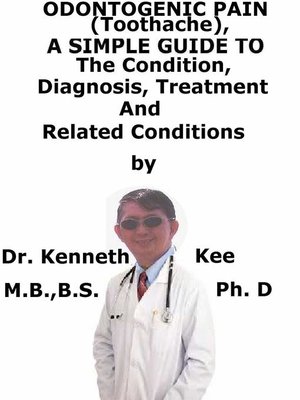Odontogenic Pain (Toothache), a Simple Guide to the Condition, Diagnosis, Treatment and Related Conditions
ebook
By Kenneth Kee

Sign up to save your library
With an OverDrive account, you can save your favorite libraries for at-a-glance information about availability. Find out more about OverDrive accounts.
Find this title in Libby, the library reading app by OverDrive.



Search for a digital library with this title
Title found at these libraries:
| Library Name | Distance |
|---|---|
| Loading... |
This book describes Odontogenic Pain (Toothache), Diagnosis and Treatment and Related Diseases
Toothache is seen very commonly in a family doctor clinic even though it is under the domain of dental surgeons.
There is normally pain and swelling of the pulp of the tooth.
Many patients prefer to seek the help of family doctors than the dental surgeons because of their trust in family doctors and the higher cost of dental surgeons.
Odontogenic Pain (Toothache) is the pain around the teeth or jaws normally after a tooth or jaw problem.
A toothache is the severe pain in or around a tooth.
Toothache can be very severe and may cause the sufferer many sleepless nights.
A toothache is often the effect of dental cavities (decay) or an infection or irritation of the tooth.
Toothache is a painful sensation beginning from the teeth or the tissues that enclose them.
It is produced by inflammation of the dental pulp (the nerves and blood vessels inside the teeth).
Toothache happens from inflammation of the central portion of the tooth called pulp which contains nerve endings that are very sensitive to pain.
Any inflammation to the pulp may be caused by dental cavities, trauma, and infection.
Referred pain from the jaw may cause one to have symptoms of toothache.
When the pulp becomes inflamed, this is termed pulpitis.
Anybody who has felt severe toothache knows that the pain can be agonizing.
It is mentioned by many people as the worst pain they have ever had.
This makes clear why toothache remains the most frequent reason for emergency dental attendance and is a frequent reason for absence from work or school.
A tooth is made of three layers:
1.Enamel: the hard outer layer of teeth above the gum.
2.Dentine: the slightly softer layer under the enamel.
3.Pulp: nerves and blood vessels in the centre of a tooth.
The dentine is made of a densely packed set of microscopic tubes extending from the enamel to the pulp.
When the dentine drops its protective layer of enamel, then harmful substances like germs, toxins and hot, cold or sweet stimuli are capable of passing along the tubes of the dentine and produce a harmful and painful effect on the living pulp underneath.
The pulp reacts to these harmful stimuli by becoming inflamed (this is called pulpitis) as it attempts to repair and defend itself.
There are 2 forms of pulpitis:
1.Reversible pulpitis: where the damage to the pulp is not extensive and has the possibility to heal if the tooth receives proper dental treatment.
2.Irreversible pulpitis: where the inflammation and damage within the pulp is too extensive for the pulp to survive even with prompt dental treatment.
Tooth decay is often produced by poor dental hygiene.
It may also be partially inherited.
The causes of Toothache are:
A. Tooth Disorders such as:
1. Dental caries which is produced by the action of the bacteria that lives in plague, a sticky coating of saliva and food debris that attaches to the surface of the teeth.
2 .Broken tooth
3. Exposed tooth root
4. Dental abscess
5. Gum disease
6. Tightening of braces
B. Disorders of the temporo-mandibular joints such as:
1. Temporomandibular joint arthritis
2. Injuries to the jaw or joint
Toothache and jaw pain are frequent complaints.
Other signs and symptoms are:
1. Pain with chewing
2. Hot or cold sensitivity
3. Bleeding or discharge from around a tooth or gums
4.Swelling around a tooth or the jaw
5.Injury to the area
Diagnosis is by:
Percussion testing
Testing for cracks
X-rays







